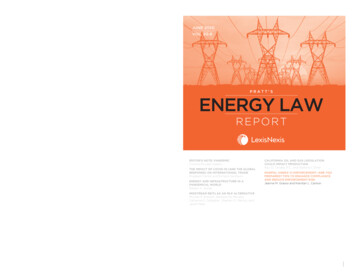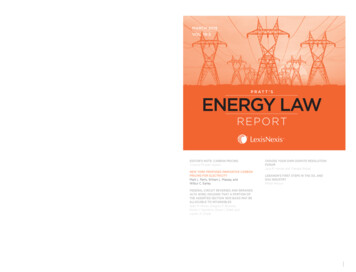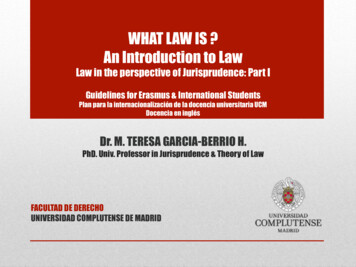
Transcription
JUNE 2020VOL. 20-6PRATT’S Energy Law ReportP RA T T ’ sEnergy LawReportEDITOR’S NOTE: PANDEMICVictoria prussen SpearsTHE IMPACT OF COVID-19 (AND THE GLOBALRESPONSE) ON INTERNATIONAL TRADEelizabeth Farrell and Richard SwinburnJUNE 2020ENERGY AND INFRASTRUCTURE IN APANDEMICAL WORLDRobert A. JamesMIDSTREAM REITs AS AN MLP ALTERNATIVEMichael p. Bresson, Barbara De Marigny,Catherine S. Gallagher, Stephen D. Marcus, andJared MeierCALIFORNIA OIL AND GAS LEGISLATIONCOULD IMPACT PRODUCTIONpaul D. tanaka, p.C., and Stefanie I. GitlerMARPOL ANNEX VI ENFORCEMENT—ARE YOUPREPARED? TIPS TO ENHANCE COMPLIANCEAND REDUCE ENFORCEMENT RISKJeanne M. Grasso and Kierstan L. Carlsonvol. 20-6
Pratt’s Energy Law ReportVOLUME 20NUMBER 6June 2020Editor’s Note: PandemicVictoria Prussen Spears175The Impact of COVID-19 (and the Global Response) onInternational TradeElizabeth Farrell and Richard Swinburn177Energy and Infrastructure in a Pandemical WorldRobert A. James189Midstream REITs as an MLP AlternativeMichael P. Bresson, Barbara De Marigny, Catherine S. Gallagher,Stephen D. Marcus, and Jared Meier193California Oil and Gas Legislation Could Impact ProductionPaul D. Tanaka, P.C., and Stefanie I. Gitler200MARPOL Annex VI Enforcement—Are You Prepared?Tips to Enhance Compliance and Reduce Enforcement RiskJeanne M. Grasso and Kierstan L. Carlson203
QUESTIONS ABOUT THIS PUBLICATION?For questions about the Editorial Content appearing in these volumes or reprint permission,please email:Jacqueline M. Morris at . (908) 673-1528Email: . jacqueline.m.morris@lexisnexis.comOutside the United States and Canada, please call . . . . . . . . . . . . . . . (973) 820-2000For assistance with replacement pages, shipments, billing or other customer service matters,please call:Customer Services Department at . . . . . . . . . . . . . . . . . . . . . . . . . . (800) 833-9844Outside the United States and Canada, please call . . . . . . . . . . . . . . . (518) 487-3385Fax Number . . . . . . . . . . . . . . . . . . . . . . . . . . . . . . . . . . . . . . . . (800) 828-8341Customer Service Website . . . . . . . . . . . . . . . . . . . http://www.lexisnexis.com/custserv/For information on other Matthew Bender publications, please callYour account manager or . . . . . . . . . . . . . . . . . . . . . . . . . . . . . . .Outside the United States and Canada, please call . . . . . . . . . . . . . . . .(800) 223-1940(937) 247-0293ISBN: 978-1-6328-0836-3 (print)ISBN: 978-1-6328-0837-0 (ebook)ISSN: 2374-3395 (print)ISSN: 2374-3409 (online)Cite this publication as:[author name], [article title], [vol. no.] PRATT’S ENERGY LAW REPORT [page number](LexisNexis A.S. Pratt);Ian Coles, Rare Earth Elements: Deep Sea Mining and the Law of the Sea, 14 PRATT’S ENERGYLAW REPORT 4 (LexisNexis A.S. Pratt)This publication is designed to provide authoritative information in regard to the subject matter covered. Itis sold with the understanding that the publisher is not engaged in rendering legal, accounting, or otherprofessional services. If legal advice or other expert assistance is required, the services of a competentprofessional should be sought.LexisNexis and the Knowledge Burst logo are registered trademarks of RELX Inc. Matthew Bender, theMatthew Bender Flame Design, and A.S. Pratt are registered trademarks of Matthew Bender Properties Inc.Copyright 2020 Matthew Bender & Company, Inc., a member of LexisNexis. All Rights Reserved.No copyright is claimed by LexisNexis or Matthew Bender & Company, Inc., in the text of statutes,regulations, and excerpts from court opinions quoted within this work. Permission to copy material may belicensed for a fee from the Copyright Clearance Center, 222 Rosewood Drive, Danvers, Mass. 01923,telephone (978) 750-8400.Editorial Office230 Park Ave., 7th Floor, New York, NY 10169 (800) 543-6862www.lexisnexis.com(2020–Pub.1898)
Editor-in-Chief, Editor & Board ofEditorsEDITOR-IN-CHIEFSTEVEN A. MEYEROWITZPresident, Meyerowitz Communications Inc.EDITORVICTORIA PRUSSEN SPEARSSenior Vice President, Meyerowitz Communications Inc.BOARD OF EDITORSSAMUEL B. BOXERMANPartner, Sidley Austin LLPANDREW CALDERPartner, Kirkland & Ellis LLPM. SETH GINTHERPartner, Hirschler Fleischer, P.C.STEPHEN J. HUMESPartner, Holland & Knight LLPR. TODD JOHNSONPartner, Jones DayBARCLAY NICHOLSONPartner, Norton Rose FulbrightBRADLEY A. WALKERCounsel, Buchanan Ingersoll & Rooney PCELAINE M. WALSHPartner, Baker Botts L.L.P.SEAN T. WHEELERPartner, Latham & Watkins LLPHydraulic Fracturing DevelopmentsERIC ROTHENBERGPartner, O’Melveny & Myers LLPiii
Pratt’s Energy Law Report is published 10 times a year by Matthew Bender & Company, Inc.Copyright 2020 Matthew Bender & Company, Inc., a member of LexisNexis. All RightsReserved. No part of this journal may be reproduced in any form—by microfilm, xerography, orotherwise—or incorporated into any information retrieval system without the written permissionof the copyright owner. For customer support, please contact LexisNexis Matthew Bender, 9443Springboro Pike, Miamisburg, OH 45342 or call Customer Support at 1-800-833-9844. Directany editorial inquiries and send any material for publication to Steven A. Meyerowitz,Editor-in-Chief, Meyerowitz Communications Inc., 26910 Grand Central Parkway Suite 18R,Floral Park, New York 11005, smeyerowitz@meyerowitzcommunications.com, 646.539.8300.Material for publication is welcomed—articles, decisions, or other items of interest to lawyers andlaw firms, in-house counsel, government lawyers, senior business executives, and anyoneinterested in privacy and cybersecurity related issues and legal developments. This publication isdesigned to be accurate and authoritative, but neither the publisher nor the authors are renderinglegal, accounting, or other professional services in this publication. If legal or other expert adviceis desired, retain the services of an appropriate professional. The articles and columns reflect onlythe present considerations and views of the authors and do not necessarily reflect those of thefirms or organizations with which they are affiliated, any of the former or present clients of theauthors or their firms or organizations, or the editors or publisherPOSTMASTER: Send address changes to Pratt’s Energy Law Report, LexisNexis MatthewBender, 230 Park Ave. 7th Floor, New York NY 10169.iv
MARPOL Annex VI Enforcement—Are YouPrepared? Tips to Enhance Compliance andReduce Enforcement RiskBy Jeanne M. Grasso and Kierstan L. Carlson*In this article, the authors explain that, with “IMO 2020” now in effect,ship owners and operators trading in U.S. waters should take steps to reducethe risk of an enforcement action.The United States has been aggressively enforcing compliance with theInternational Convention for the Prevention of Pollution from Ships (“MARPOL”)for nearly 30 years. Enforcement actions have been brought against ship ownersand operators across the industry, as well as against individual masters,engineers, shoreside personnel, and other corporate officers.To date, most MARPOL prosecutions have involved violations of MARPOLAnnex I through “magic pipe” bypasses of the Oily Water Separator (“OWS”)or improper discharges of sludge, though some have involved Annex V garbageviolations and, very recently, Annex VI emissions violations. Few, other than inthe early 1990s, have involved illegal discharges in U.S. waters; rather, virtuallyall cases have been brought for false entries in the ship’s records, including theOil Record Book (“ORB”) and Garbage Record Book. This is becausemaintaining inaccurate records while in domestic waters or presenting inaccurate records to the U.S. Coast Guard (“USCG”) during an inspection is a crimeand the jurisdictional hook needed for prosecution. Most cases also involvesome kind of unlawful “post-incident conduct” that constitutes an independentcrime under U.S. law, such as destroying records or lying to USCG inspectorsor special agents.While most countries view recordkeeping violations for illegal dischargesoccurring in international waters as within the purview of the flag State, theU.S. government disagrees—evidenced by the approximately eight to 10MARPOL prosecutions per year for at least the last decade, including eight in2018 and nine in 2017, all of which have resulted in high penalties and/or jailtime, as well as reputational harm to the ship owners and operators. Not onlyare MARPOL Annex I prosecutions likely to continue, but we also expect U.S.authorities to begin focusing more heavily on violations of MARPOL Annex VI*Jeanne M. Grasso, a partner in the Washington, D.C., office of Blank Rome LLP, isco-chair of the Maritime & International Trade Practice Group and a member of the firm’sMaritime Emergency Response Team. Kierstan L. Carlson is an associate in the firm’s Maritime& International Trade Practice Group in the Washington, D.C., office. The authors may becontacted at grasso@blankrome.com and carlson@blankrome.com, respectively.203
PRATT ’S ENERGY LAW REPORT(air emissions) now that the worldwide sulfur limit of 0.50 percent is in effect.The United States brought the first Annex VI criminal case in 2019, followingthe same playbook it uses in Annex I cases. And, with the implementation ofthe 2020 sulfur cap, and all of the compliance challenges that come along withit, the risk of an enforcement action is that much greater. Ship owners andoperators must take steps now to ensure compliance with Annex VI, includingmaintaining accurate records, or risk becoming a target in the next port statecontrol inspection.IMO 2020 AND THE RESULTING COMPLIANCE CHALLENGESKnown widely as “IMO 2020” or the “2020 sulfur cap,” significantamendments to the fuel sulfur standards under MARPOL Annex VI came intoeffect in 2020.First, as of January 1, 2020, the worldwide limit for sulfur content in bunkerfuel oil is 0.50 percent for ships operating outside of emission control areas(“ECAs”).Second, a ban on the carriage of non-compliant fuel went into effect onMarch 1, 2020. The only exception to this rule is that ships fitted with exhaustgas cleaning systems (often referred to as “scrubbers”) will be permitted to carryfuel with a higher sulfur content. Importantly, none of these changes impactsthe fuel sulfur limit applicable within ECAs—that limit has been 0.10 percentsince 2015 and will remain in effect.The 0.50 percent limit required under IMO 2020 is a substantial reductionfrom the prior limit of 3.50 percent. To comply, ships must do one of threethings:(1) Carry and use only compliant fuel on board;(2) Equip ships with scrubbers; or(3) Plan for ships that can be powered through alternative means, such asliquefied natural gas (“LNG”).Undoubtedly, each of these options may present challenges for ship ownersand operators. Opting to use compliant fuel will require careful planning andalso presents concerns about engine compatibility and fuel blending. Plus, theUSCG has signaled that ships submitting fuel oil non-availability reports willreceive additional scrutiny and likely will be boarded.Comparably, opting to comply by utilizing scrubbers requires ships tomanage wastes and/or washwater, which cannot be discharged in certain U.S.states and various countries, and to plan for potential equipment failures.Finally, running a ship on LNG or some other alternate fuel must be plannedyears in advance, generally when the ship is built, and is often not a realisticoption for ships already in service.204
MARPOL ANNEX VI ENFORCEMENTU.S. ANNEX VI ENFORCEMENT TO DATE AND IMPACT OFIMO 2020U.S. authorities have a range of enforcement options for violations ofMARPOL Annex VI, including the issuance of letters of warning (“LOWs”),which carry no penalty; notices of violation (“NOVs”), which carry a penaltyup to 10,000; the imposition of a civil penalty up to 74,552 per violation;and referral of the matter to the U.S. Environmental Protection Agency(“EPA”) for investigation or to the U.S. Department of Justice for criminalenforcement. The trigger for a criminal enforcement action will commonly befalsifying records to demonstrate compliance when a ship is not in compliance.Until recently, and as companies have been adjusting to the North Americanand Caribbean ECAs over the past few years, Annex VI enforcement has beenlimited primarily to LOWs and NOVs, and a few civil penalty actions from theEPA. But the tide is changing. In August 2019, the United States concluded itsfirst-ever Annex VI criminal prosecution. Two shipping companies wereconvicted and sentenced to pay a total fine of three million dollars for violationsof Annex VI for using non-compliant fuel in the Caribbean ECA, failing tomaintain an accurate ORB, maintaining false bunker delivery notes (“BDNs”),and obstructing justice. The conduct involved the vessel siphoning off fuel fromcargo tanks and creating fake BDNs to show that the fuel was acquiredshoreside. That said, the BDNs indicated that the vessel was nonethelessburning non-compliant fuel, which naturally caught the USCG’s attentionduring a port state control exam. There is little doubt that the case serves as awarning that the United States is not going to take Annex VI violations lightly.To that end, the USCG has issued guidelines for compliance and enforcement of the U.S. ECAs and Annex VI generally (CG-CVC Policy Letter 12-04,Change 1). The USCG also has spelled out exactly how compliance with AnnexVI will be verified: the USCG will review BDNs, fuel change-over procedures,and other documentation to assess compliance; and if warranted under thecircumstances—e.g., the ship is missing BDNs, the BDNs indicate noncompliant fuel, the crew are unfamiliar with or not following procedures—theUSCG will expand the inspection. This mirrors how the USCG would handlethe discovery of a potential Annex I violation and it is exactly how thegovernment handled the Annex VI criminal case. We also expect that theUSCG would respond to a whistleblower report of an Annex VI violation justas it would to a reported OWS bypass: the USCG would immediately proceedwith an expanded MARPOL examination followed by an investigation byspecial agents.The USCG’s enhanced scrutiny of BDNs and other vessel records increasesthe possibility that some non-compliance could be found, as well as that a ship’s205
PRATT ’S ENERGY LAW REPORTcrewmembers could expose the company to liability by attempting to hide theirmisconduct. The whistleblower provisions contained in the Act to PreventPollution from Ships, which implements MARPOL in the United States,presents an additional layer of complexity, as it could incentivize crewmembersto report problems to the USCG rather than to shoreside managers, as we haveseen with Annex I violations.RECOMMENDATIONS TO ENSURE COMPLIANCE AND REDUCEENFORCEMENT RISKThe risks of a potential enforcement action for noncompliance withMARPOL remain high if companies do not have the proper compliancesystems in place. The United States has been regularly prosecuting companiesand individuals for decades and expects that companies operating in U.S. watersunderstand the risks associated with failing to comply with MARPOL. This willnot change simply because the focus may be shifting to Annex VI. Ship ownersand operators must become vigilant about MARPOL compliance overall andproactively review and strengthen their compliance regimes in order tominimize the risks of becoming the target of a MARPOL enforcement action,along with the financial and reputational harm that comes with it.In some cases, enforcement actions have resulted from a company’s unwillingness to invest time and money into compliance. But in others, they haveresulted from a flaw in an otherwise adequate compliance program. Indeed, nocompany, even one with resources, upgraded equipment, and procedures galore,is immune from a mistake. There is always room for improvement—and roomto reduce risk.Environmental compliance is dependent primarily on:(1)The competence and training of the ship’s complement;(2)A comprehensive environmental management system, which includesverification;(3)The degree of shoreside management oversight employed; and(4)The strength of the overall corporate compliance culture.There is no reason to believe this will change if/when the enforcement focusshifts to Annex VI. Therefore, we recommend ship owners and operatorsdedicate resources to improving the following management practices to createa culture of compliance to reduce risk: Enhanced Compliance Training: Creating a sustainable complianceculture aboard the ship is difficult due to frequent crew rotations andthe unpredictability of future vessel assignments. But, enhancedtraining programs for both engineering officers and unlicensed crew206
MARPOL ANNEX VI ENFORCEMENTmembers are a must—they ensure that the officers and crew areknowledgeable and prepared, but they also communicate the company’scommitment to rigorous compliance standards—and that noncompliance will not be tolerated. Open Reporting System: Anonymous hotlines or other electronic reporting methods through which crewmembers can alert shoreside management of environmental deficiencies or violations aboard a ship areimperative; the lack of an anonymous reporting mechanism is viewedskeptically by U.S. enforcement authorities. Some companies have eveninstituted an internal monetary reward system for crewmembers whoprovide accurate information regarding environmental problems as ameans to counterbalance incentives offered for whistleblowing. Verification/Audit Program: A periodic audit program, including unannounced audits, is a critical element of a robust environmentalcompliance program. Whether conducted internally or by third-partyconsultants, routine audits can uncover problems and allow thecompany to correct non-compliances before they turn into enforcement concerns. Regular spot checks of records and verification ofcompliance outside the audit function is also important. Role of Superintendent: Periodic shipboard visits by the technicalsuperintendent are vital; their detailed knowledge of the ship andfamiliarity with the engineering officers and crewmembers allowsuperintendents to identify conditions in the engine room that raiseenvironmental compliance issues. Superintendents must take the timewhile aboard to speak with the ratings and officers, carry the compliance message from shore to ship, and be instructed to promptly informshoreside management of any compliance issues so they can be dealtwith promptly. Internal Investigations: If the company has information suggesting thatan intentional MARPOL violation (whether Annex I, V, or VI) hasoccurred or is ongoing aboard a vessel, a company should conduct animmediate internal investigation, in consultation with counsel. Manycircumstances will warrant counsel conducting the investigation. Counsel can develop a complete factual record and provide legal adviceconcerning any corrective actions or reporting obligations that mayexist. Taking initiative early on can help to control the potentialnegative consequences of any identified MARPOL deficiency, whilestrengthening the company’s overall environmental compliance program.Should a company find itself in the unenviable position of discovering aMARPOL non-compliance, we recommend considering disclosure to the ship’s207
PRATT ’S ENERGY LAW REPORTflag State and possibly to the U.S. Coast Guard if a U.S. port call isforthcoming. Consultation with counsel plays a critical role in whether, how,and to whom such a disclosure should be made. While port and coastal statesare authorized to perform port state control inspections or to investigate andconsider enforcement actions for pollution events occurring in their territorialwaters, these functions are secondary to the primary environmental complianceassurance role reserved to the flag State under international law.CONCLUSIONThe United States has long been the most aggressive enforcer of MARPOL,whether or not the violations occur in U.S. waters, and this trend will continue.With IMO 2020 in effect, the enforcement focus is expanding and alreadyshifting to Annex VI. Ship owners and operators trading in U.S. waters shouldtake steps now to reduce the risk of an enforcement action: strengthen and testyour compliance program; plan for potential problems relating to compliantfuel or scrubbers; and be prepared to immediately address any non-complianceif or when it arises.208
("ECAs"). Second, a ban on the carriage of non-compliant fuel went into effect on March 1, 2020. The only exception to this rule is that ships fitted with exhaust gas cleaning systems (often referred to as "scrubbers") will be permitted to carry fuel with a higher sulfur content. Importantly, none of these changes impacts










